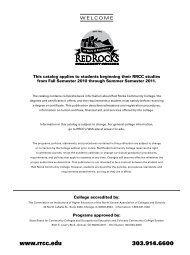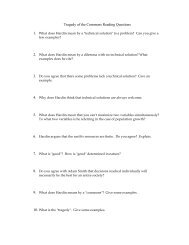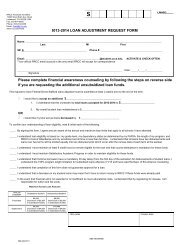opportunities, options, excellence - Red Rocks Community College
opportunities, options, excellence - Red Rocks Community College
opportunities, options, excellence - Red Rocks Community College
Create successful ePaper yourself
Turn your PDF publications into a flip-book with our unique Google optimized e-Paper software.
OSH 255 Instrument Laboratory<br />
2 Credits<br />
This course prepares students to calibrate and<br />
utilize industrial hygiene instrumentation.<br />
Direct Reading Instruments and Personal<br />
Sampling Pums are covered.<br />
OSH 261 Independent Study<br />
3 Credits<br />
This course provides an opportunity for students<br />
to work on Occupational Safety- related<br />
research projects. Research projects vary and<br />
are assigned by the advisor based on your<br />
need.<br />
OSH 290 Direct In-Service<br />
Internship<br />
12-18 Credits<br />
This course is designed for employees working<br />
in a safety and/or health department who<br />
wish to further their education in occupational<br />
safety. Students may substitute internship<br />
credit for appropriate occupational safety<br />
courses required for the AAS degree or certificate.<br />
Appropriate credit is determined by<br />
an advisor.<br />
OSH 296 Pre-Service Internship<br />
5-12 Credits<br />
This course is for those of students who do<br />
not have prior industrial experience in safety<br />
and wish to expand their understanding and<br />
knowledge of industrial processes and problems.<br />
Students may substitute internship credit<br />
for appropriate occupational safety courses<br />
required for the AAS degree. Appropriate<br />
credit is determined by an advisor.<br />
PAP - PHYSICIAN<br />
ASSISTANT<br />
Note: the Physician Assistant curriculum is<br />
under constant evaluation and elements of the<br />
required courses may be changed by the collegewithout<br />
notice. Admission to the PA<br />
Program is a prerequisite to each course.<br />
PAP 200 Biochemistry and Cell<br />
Biology<br />
3 Credits<br />
This course introduces major topics in modern<br />
biochemistry, cell biology and human<br />
genetics. The chemistry of proteins, carbohydrates,<br />
lipids and nucleic acids are studied.<br />
How these components function and are<br />
involved in basic metabolic processes such as<br />
cellular respiration, lipid metabolism, protein<br />
synthesis and DNA replication are also covered.<br />
The basic conceptual background is provided<br />
to allow students to understand disease<br />
mechanisms, clinical lab tests and drug<br />
effects.<br />
PAP 203 Health Care Issues<br />
1 Credit<br />
This course reviews the history of the physician<br />
assistant profession and describes the<br />
physician assistant's responsibilities and functions<br />
within a variety of health care delivery<br />
systems. The relationships between the physician<br />
assistant, the physician and other health<br />
care providers are explored. Legal and ethical<br />
issues and quality assurance in PA practice<br />
are discussed.<br />
PAP 205 Human Anatomy and<br />
Development<br />
3 Credits<br />
This course presents functional and applied<br />
anatomy as it relates to common clinical findings.<br />
The object of this course is to provide<br />
students with a solid understanding of the<br />
structure of the human body, with emphasis<br />
on normal vs. abnormal findings. Some of the<br />
areas covered include the musculoskeletal,<br />
nervous, cardiovascular, urinary, respiratory,<br />
digestive and reproductive systems.<br />
PAP 207 Health Promotion and<br />
Disease Prevention<br />
1 Credit<br />
This course is intended for students who will<br />
provide clinical preventive services as part of<br />
primary care, counseling interventions,<br />
screening tests, immunizations and chemoprophylaxis.<br />
This course gives special emphasis<br />
to counseling patients about risk factors.<br />
Conventional and alternative prevention<br />
strategies will be discussed.<br />
PAP 210 Human Physiology<br />
3 Credits<br />
This course provides students with an<br />
improved understanding of human physiology<br />
as it relates to clinical medicine. Through lectures<br />
and examinations, students study the<br />
functional organization of the human body,<br />
membrane physiology, nerve and muscle tissue<br />
function, the cardiovascular system, the<br />
lymphatic system, the immune system, respiration,<br />
digestion, renal function, metabolism<br />
and temperature regulation, endocrinology<br />
and human reproduction.<br />
PAP 212 Introduction to Emergency<br />
Medicine<br />
PAP 217 Introduction to Laboratory<br />
Medicine<br />
1 Credit<br />
This course to teacher students basic diagnostic<br />
and therapeutic clinical skills. The indications,<br />
normal findings, risks, benefits and<br />
costs of common basic diagnostic tests will be<br />
discussed.<br />
PAP 218 Medical Literature<br />
1 Credit<br />
This course provides students with an<br />
approach to reading and understanding the<br />
medical literature. The fundamental principles<br />
of epidemiology will be addressed. Students<br />
will develop the necessary skills to evaluate<br />
study design and execution. Methods in<br />
which data are analyzed and interpreted will<br />
be described and evaluated.<br />
PAP 219 Medical Interviewing Skills<br />
1 Credit<br />
This course teaches the oral techniques<br />
required to obtain a complete medical history.<br />
Students will develop and/or enhance their<br />
communication skills and learn to use these<br />
skills to interact effectively in professional<br />
relationships. This course explores the links<br />
between culture and communication.<br />
Communication techniques appropriate to<br />
multicultural society will be addressed.<br />
PAP 220 Physical Examination<br />
Techniques<br />
1 Credit<br />
This course teaches the techniques required to<br />
perform a complete physical examination of<br />
patients of all ages. Practice sessions and<br />
mock patients are used to develop the practical<br />
skills necessary to perform these tasks in<br />
everyday clinical practice.<br />
PAP 221 Clinical Medicine I<br />
3 Credits<br />
This course provides students with a beginning<br />
understanding of how clinicians<br />
approach the diagnosis and treatment of specific<br />
disease states. In conjunction with<br />
Human Pathology curriculum, students will<br />
learn to identify the signs and symptoms of<br />
common disorders, to further evaluate those<br />
disorders through appropriate testing and to<br />
prepare a treatment plan to preserve health or<br />
mitigate suffering. Topics to be covered<br />
include: cardiopulmonary, endocrine, dermatology,<br />
hematology, opthamology, otolaryngologic,<br />
oncology, immunologic, allergy and<br />
infectious disease.<br />
PAP 222 Clinical Medicine II<br />
3 Credits<br />
Presentations and small group experiences<br />
will examine common patient conditions in<br />
pulmonary, gastrointestinal, genito-urinary,<br />
neuromuscular, men’s health, orthopedics,<br />
rheumatoid and geriatrics. Emphasis will be<br />
on developing patient and assessment treatment<br />
plans. Students will learn to identify the<br />
<strong>opportunities</strong>, <strong>options</strong>, <strong>excellence</strong> 160
















